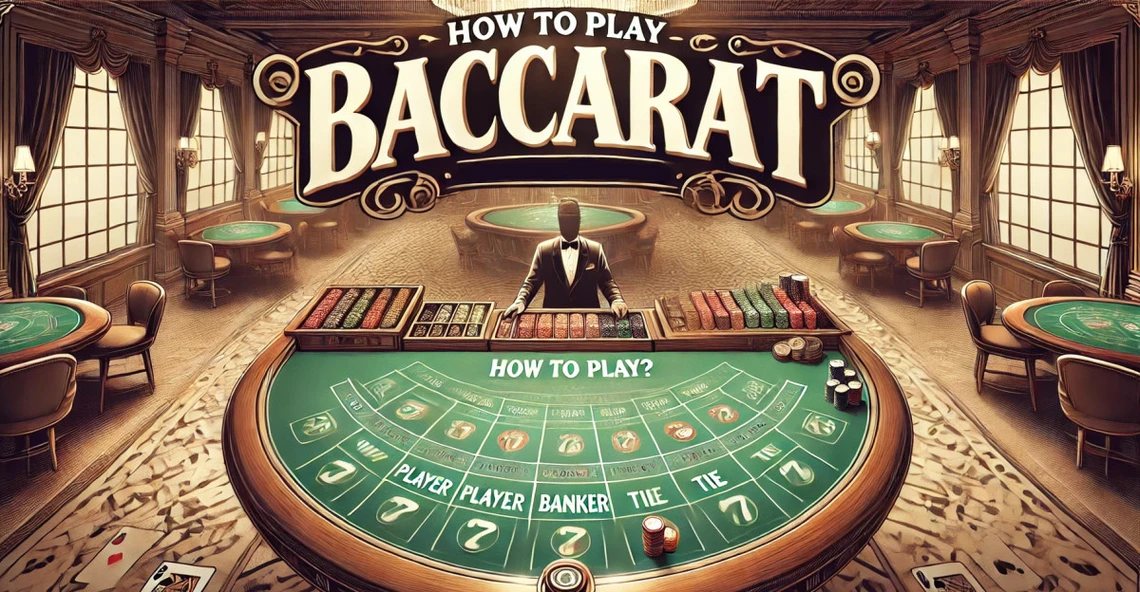
How To Play Baccarat?

Baccarat is a classic casino game, appreciated for its simplicity and speed. Originating in Italy, it became popular in France in the 15th century before spreading to casinos worldwide. Today, it attracts players both in land-based casinos and online casino platforms.
In this article, learn step-by-step how to play Baccarat, from placing bets to the progression of a game. It’s an easy game to learn and highly accessible for players of all levels.
Basic Rules of Baccarat Video
The goal of Baccarat is to bet on the hand that comes closest to 9 points. You can bet on the player’s hand, the banker’s hand, or a tie.
Card Distribution
Two cards are dealt to each hand: one for the player and one for the banker. Depending on the total points, a third card may be drawn according to specific rules.
Types of Bets
- Player Bet: This is a bet placed on the player’s hand winning the round by having a point total closer to 9 than the banker’s hand. If the player’s hand has a higher value, this bet wins.
- Banker Bet: This is a bet placed on the banker’s hand winning the round by having a point total closer to 9 than the player’s hand. The banker bet has a slight statistical advantage but often involves a commission on winnings due to this higher probability of success.
- Tie Bet: This is a bet that the player’s and banker’s hands will have the same point total, resulting in a tie. While it offers a higher payout, the tie bet is generally considered riskier because ties occur less frequently.
Point Calculation
- Numbered cards (2 to 9): Keep their face value.
- Ace: Worth 1 point.
- 10, Jack, Queen, King: Worth 0 points.
- The point total is calculated by adding the values of the cards, and then taking only the unit digit. Some examples :
- A hand with cards 4 and 9 (4+ 9 = 13) The unit digit is 3, so the total is 3.
- A hand with cards Q and 6 (0 + 6 = 6) The unit digit is 6, so the total is 6.
- A hand with cards 8 and 9 (8 + 9 = 17) The unit digit is 7, so the total is 7.
- A hand with cards 10 and 9 (0 + 9 = 9) The unit digit is 9, so the total is 9.
A table with the values of each card in Baccarat:
|
Card
|
Value
|
|---|---|
|
Ace |
1
|
|
2 |
2
|
|
3 |
3
|
|
4 |
4
|
|
5 |
5
|
|
6 |
6
|
|
7 |
7
|
|
8 |
8
|
|
9 |
9
|
|
10 |
0
|
|
Jack |
0
|
|
Queen |
0
|
|
King |
0
|
Example of a Game Round
- Players place their bets on one of the options (player, banker, or tie).
- The dealer deals two cards to the player and two to the banker.
- Points are calculated for each hand; if a hand scores 8 or 9, it’s called a “natural,” and the game stops here to determine the winner.
- If no “natural” is achieved, additional rules may apply for a third card, based on the scores of each hand.
- The dealer declares the winning hand, and the winnings are distributed according to the bets placed.
Betting Options and Probabilities in Baccarat
Betting Options
- Player Bet: Pays 1 to 1, with a return rate close to 98.76%.
- Banker Bet: Pays 1 to 1 with a 5% commission on winnings. This bet has a slight advantage, with a return rate of 98.94%.
- Tie Bet: Offers a payout of 8 to 1, but with a much lower return rate (around 85.64%), making it a risky choice.
Probabilities and House Edge
- Banker Bet: Has the highest winning probability, with a house edge of around 1.06%.
- Player Bet: Has a house edge of approximately 1.24%.
- Tie Bet: Has a much higher house edge, around 14.36%, making it far less profitable in the long run.
|
Betting Option
|
Payout
|
Return Rate
|
Win Probability
|
House Edge
|
|---|---|---|---|---|
|
Player Bet |
1 to 1
|
98.76%
|
44.62%
|
1.24%
|
|
Banker Bet (-5% commission) |
1 to 1
|
98.94%
|
45.85%
|
1.06%
|
|
Tie Bet |
8 to 1
|
85.64%
|
9.53%
|
14.36%
|
Mistakes to Avoid in Baccarat
To avoid unpleasant surprises in Baccarat, here are a few common mistakes to steer clear of:
Betting Too Often on a Tie
The tie bet, though tempting with its high 8-to-1 payout, is risky. With a low win probability (around 9.53%) and a high house edge (14.36%), it should be avoided in most cases.
Ignoring the Commission on the Banker Bet
While betting on the banker is statistically the safest option, remember that a 5% commission is deducted from winnings. Factor this in to avoid overestimating your potential gains.
Strategies or Pure Game of Chance?
Baccarat is primarily a game of chance. Each draw is independent, and there’s no way to predict the outcome of hands. However, some players adopt betting strategies for Baccarat, such as the Martingale (increasing the bet after each loss) or budget management systems to better control their gains and losses.
It’s important to note that these strategies only affect money management and not the odds of winning, which remain unchanged. In short, while certain methods can help manage your budget, Baccarat remains a game of chance, where no strategy guarantees long-term wins.
The Different Variants of Baccarat
Baccarat comes in several variants, each with its own rules. Here’s an overview of the main versions to help you choose the one that suits you best.
- Punto Banco
This is the most common version, especially in North American casinos. In Punto Banco, players bet against the casino, which acts as the banker. The card-drawing rules are fixed, and the player has no decisions to make, making the game quick and accessible. - Chemin de Fer
Popular in Europe, this version allows players to play against each other, with the role of banker rotating among them. The banker decides whether to draw or stand, offering more control to participants. This variant adds a strategic element, as players’ decisions can influence the outcome. - Baccarat Banque
In this variant, the banker’s role remains fixed for several rounds, usually until the deck is exhausted or the banker decides to pass. Often played in France, this format allows for longer and more structured games, where the banker plays a central role.
Each Baccarat variant offers a unique experience. If you prefer a simple, fast game, go for Punto Banco. For more control and interaction, Chemin de Fer is a good choice. Finally, the Baccarat Banque game provides a balanced alternative for those who enjoy playing the banker’s role.
Glossary of Key Baccarat Terms
Here are a few essential terms to understand Baccarat better:
- Natural: A hand totalling 8 or 9 points with the first two cards. A “natural” immediately ends the round, and the hand with the natural wins (unless it’s a tie).
- Draw: The action of dealing a third card to the player’s or banker’s hand, according to specific drawing rules. The draw is not decided by the player but follows automatic rules based on the score.
- Baccarat: In French, the term refers to a hand totalling zero points. For example, a hand with a 10 and a 3 is a “baccarat.”
- Banker: One of the three betting options in Baccarat. Betting on the banker offers a slight statistical advantage, although a 5% commission is applied to winnings.
- Player: Another betting option, where you bet on the player’s hand. This bet pays 1 to 1 if the player’s hand wins.
- Tie: A bet that wagers on the points being equal between the player and the banker. This bet usually pays 8 to 1 but is riskier due to its low probability.
- House Edge: The casino’s statistical advantage over different bet types. It is lower on banker and player bets but higher on the tie bet.
Conclusion
In summary, Baccarat is an accessible game of chance for everyone. Understanding its basic rules, different variants, and betting options allows you to play confidently and avoid common mistakes.
Expert Opinion: While Baccarat is a game of chance, its simplicity and betting options make it an excellent choice for those looking for a quick game with easy-to-master rules. It’s ideal for players who prefer a smooth gaming experience without complex strategies.

Author
Manager
